How to Calculate Employee Retention Rate: Metrics and Strategies to Know
Last Updated Nov 4, 2025

Losing a great employee stings. Losing several? That can shake your entire organization.
Turnover doesn’t just mean job boards and interviews. It means time, money, lost momentum, and stressed-out teams. While your people juggle extra work, your culture takes a hit — and the cycle can spiral fast.
That’s why tracking your employee retention rate matters more than ever. It’s not just a number. It’s a clear signal of how well your workplace supports, engages, and holds on to talent.
Uncover the benefits of knowing your retention rate, how to calculate it the right way, and the strategies that actually move the needle.
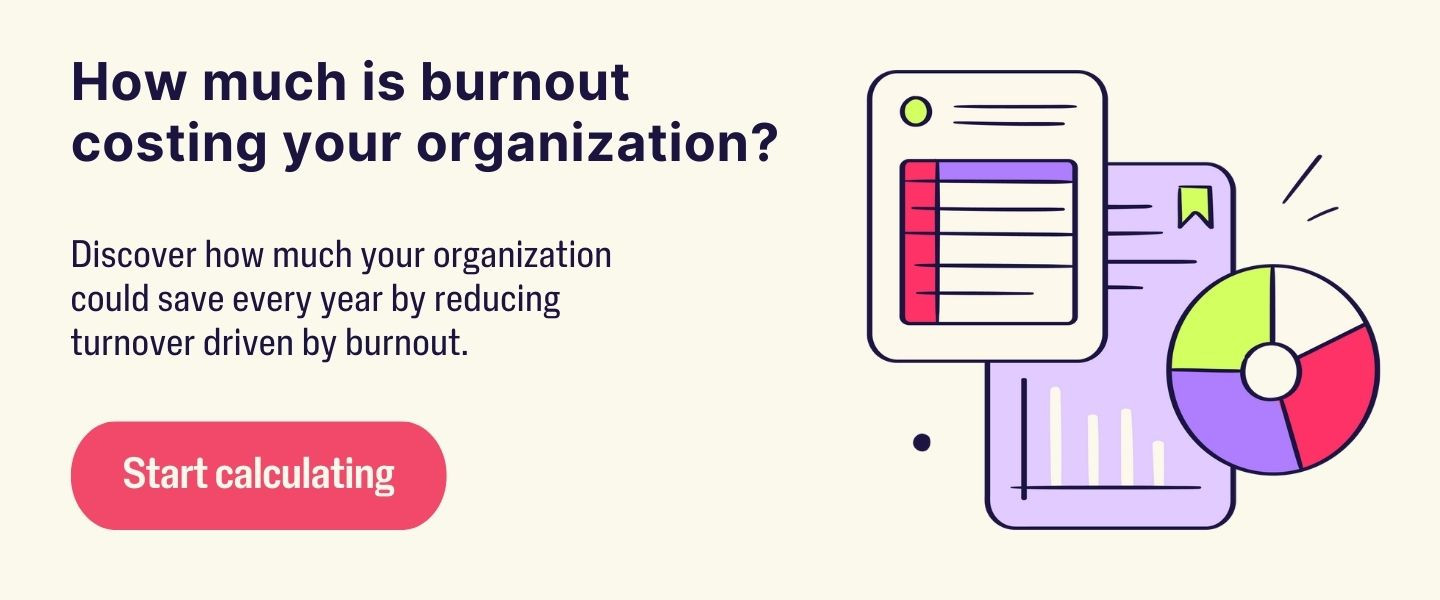
What You'll Learn
- The difference between retention rate (who stays) and turnover rate (who leaves), and why HR leaders should track both.
- How to calculate employee retention rate step by step, with a simple formula and example.
- Why retention matters: it reduces costs, strengthens culture, and boosts business performance.
- How to interpret retention data by looking at timing, demographics, voluntary vs. involuntary exits, and benchmarks.
- Best practices to improve retention, including strong onboarding, open communication, career growth opportunities, wellbeing support, and building a culture of respect.
What Is Employee Retention Rate?
Employee retention rate is the percentage of employees who remain employed at a company over a specific time period. It’s a benchmark for workforce stability, loyalty, and overall employee experience.
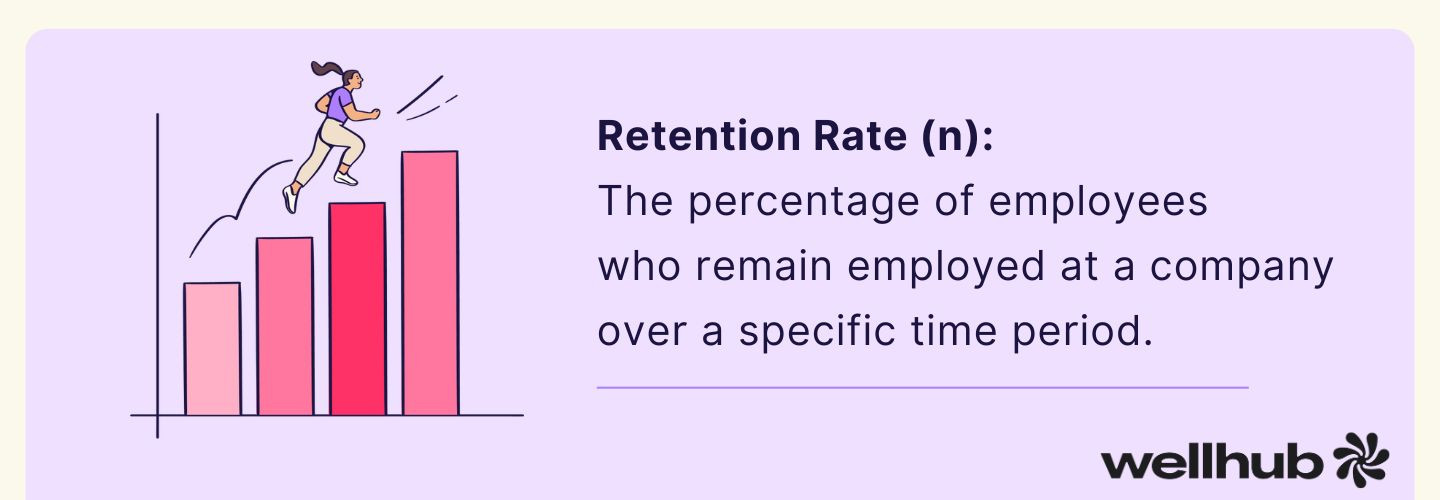
A higher retention rate suggests that staff feel supported through pay and workplace culture, and that the company has designed employee benefits for retention. A low rate suggests that your company may not be meeting employee expectations and you may experience high turnover.
Employee retention rate is connected to the “three R’s” often cited in HR:
- Respect. Showing respect to your employees is the backbone of building a strong company culture.
- Recognition. Employees that receive recognition for their work are more motivated and less likely to leave.
- Reward. Offering competitive compensation, perks, employee benefits, and employee development opportunities is important for morale and self-esteem, and encourages employees to stay and grow with the company.
By tracking retention rate, HR leaders gain an early-warning system for turnover trends and a reliable measure of whether their engagement and retention strategies are working.
Retention Rate vs. Turnover Rate
Retention rate and turnover rate are like two sides of the same coin, but they measure very different things.
Retention rate tells you how many employees stayed with your company over a certain period. Think of it as a “loyalty score.” If you start the year with 100 employees and 90 of them are still with you at the end of the year, your retention rate is 90%. High retention signals that your organization is doing a good job of keeping people engaged, satisfied, and supported.
Turnover rate, on the other hand, measures how many employees left during a specific time frame. It includes both voluntary exits (resignations) and involuntary exits (terminations or layoffs). Using the same example: if 10 employees leave over the year, your turnover rate is 10%.
Here’s a simple way to remember it:
- Retention = who stays.
- Turnover = who goes.
For HR leaders, tracking both matters. Retention highlights the effectiveness of your engagement and wellbeing strategies, while turnover shines a light on possible problem areas—like weak career paths, poor manager relationships, or a lack of wellbeing support.
4 Reasons You Need to Know Your Retention Rate
Let’s get one thing straight: your retention rate is more than just a number on a spreadsheet. It’s a window into the health of your workplace. When you understand your retention rate, you can move from reactive HR practices to proactive, strategic talent management.
Here’s why tracking and understanding retention is essential for every HR leader:
- Stability Drives Success
Retention is directly tied to organizational stability. The longer your employees stay, the more institutional knowledge they build — and that knowledge is like rocket fuel for productivity, team cohesion, and collaboration. High retention allows your teams to focus on moving forward instead of constantly pausing to train new hires.
It also strengthens employee relationships. Familiarity breeds trust, and trust builds stronger, more resilient teams.
- It’s a Massive Cost Saver
Turnover is expensive. We're talking about the full scope: recruitment costs, onboarding time, productivity lags, and even potential client churn. When your retention rate is high, you minimize those costs — plain and simple.
Retention metrics help you identify costly churn trends early and reallocate your budget toward what’s working, like leadership development or wellness programs that actually move the needle.
Pro Tip: Investing in wellness can reduce those costs even further. In fact, 67% of CEOs say their wellness programs significantly reduce absenteeism.
- It Signals a Healthy Workplace Culture
Your retention rate reflects how people feel about working at your company. High retention often signals a workplace where people feel safe, supported, and valued. That’s not just good for morale — it’s great for your employer brand.
Culture isn’t fluff — it’s strategy. And when employees stick around because they love where they work, they also advocate for your company. That’s how you build a strong talent pipeline and retain top performers.
- It’s a Business Performance Indicator
Here’s the kicker: your retention rate affects your bottom line. Employees who stay longer deliver better outcomes. They understand your systems, your clients, and your values — which helps them deliver consistent results and innovate from a place of deep understanding.
Retention can also be a key selling point for clients and partners. It signals reliability and continuity, two things every stakeholder values.
And guess what? CEOs agree — 73% say their wellbeing programs improve talent retention.
Not all turnover is the same. Find out which types matter most—and how to manage them strategically.
How to Calculate Your Employee Retention Rate (Formula)
To calculate employee retention rates, follow these five easy steps.
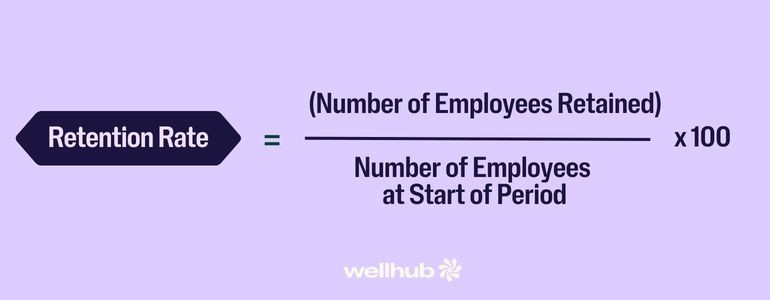
Step 1: Determine Your Time Period
Choose a consistent measurement period, such as monthly, quarterly, or yearly. Use the same timeframe across analyses to spot trends. Picking a consistent time period is important because retention trends are only useful when they’re tracked over comparable timeframes. If one department measures retention quarterly and another annually, their results can’t be compared.
A well-defined period also makes benchmarking against industry averages more accurate, since most external reports and competitor data are measured annually.
Step 2: Take a Head Count
Count the number of employees on staff at the beginning of your chosen time period. Only include employees who were working on day one, not new hires who joined later.
Step 3: Count Your Retained Employees
At the end of the period, tally how many of those original employees are still employed. Don’t include new hires who joined mid-period.
Step 4: Apply the Formula
Now, do a little math:
(Number of Employees Retained / Number of Employees at Start of Period) x 100 = Retention Rate
Step 5: Evaluate Your Results
The final percentage shows your retention rate. A high percentage suggests that your company culture is stable, while a low one means that you may need to improve your retention strategies.
Employee Retention Rate Example
Here’s an example showing how to calculate and analyze your member retention rate. Imagine you began the year with 500 employees. By year’s end, 450 of those original employees remain. When you apply the formula, you’ll end up with (450 ÷ 500) × 100 = 90%.
This number means you retained 90% of your workforce for that year.
You can't improve what you don’t measure: 12 retention KPIs every HR leader should be tracking.
How to Understand Your Employee Retention Rate
Your employee retention rate isn’t just an HR metric. It’s a mirror. It reflects what’s working — and what isn’t — in your workplace culture, leadership, and operations. But to get value out of it, you have to read it the right way.
Let’s walk through how to interpret your retention rate so you can spot red flags, uncover hidden strengths, and drive smarter decisions.
Start With the Basics: What the Number Shows
Your retention rate tells you the percentage of employees who stayed with your company over a specific time period. It helps answer one of the most important HR questions: Are people sticking around?
- High retention suggests stability, loyalty, and cultural alignment.
- Low retention may point to deeper issues like burnout, poor leadership, or lack of growth.
But this number alone won’t tell the whole story.
Dig Deeper: What’s Beneath the Surface?
To understand what your retention rate really means, break it down across these key dimensions:
- Timing
Look at when employees are leaving:
- Within the first year? You may have an onboarding, role clarity, or hiring fit issue.
- Around the two to three year mark? That’s often when employees hit a career growth ceiling.
- After 5+ years? This could be due to leadership turnover, org restructuring, or burnout.
Why it matters: Knowing when people leave tells you why they leave — and how to fix it.
- Who’s Leaving
Retention is not one-size-fits-all. Are you losing:
- High performers?
- New hires?
- Women?
- People of color?
- Managers?
Why it matters: Losing your top talent, future leaders, or diverse team members has a deeper business impact than overall headcount.
- Voluntary vs. Involuntary Turnover
Retention rate includes everyone who left — but not everyone left for the same reason.
- Voluntary exits mean something pushed them away — compensation, culture, burnout, or better offers.
- Involuntary exits (layoffs, performance terminations) may not reflect dissatisfaction but still impact morale and costs.
Why it matters: Separate the two. A high voluntary turnover rate is your urgent red flag.
- Compare to the Right Benchmarks
- Your past: Are you improving year-over-year?
- Your industry: What’s the average in your sector?
- Your departments: Where is retention strongest or weakest?
Why it matters: Context helps you avoid panic — or complacency.
- Cross-Reference with Engagement and Feedback
Your retention rate tells you who stayed. But it doesn’t tell you how they feel.
- Pair your retention data with pulse surveys, stay interviews, and exit feedback.
- Employees might stay because they love the job — or because they feel stuck.
Why it matters: Retention without engagement is a trap. Don’t confuse “still here” with “thriving here.”
Best Practices To Improve Employee Retention Rate
- Start With a Strong Onboarding Experience
Retention begins on Day One (actually, even before that).
Best Practices:
- Make onboarding intentional. Don’t just hand over a laptop and a login. Create a clear 30-60-90 day ramp plan that includes goals, cultural immersion, and regular check-ins.
- Assign a mentor or buddy. This boosts belonging and reduces early turnover.
- Streamline logistics. The less confusion about where to go or who to ask, the better the early employee experience.
Employees with a structured onboarding experience are 58% more likely to stay beyond three years, according to a Clickboard Study.

- Keep Communication Open and Transparent
Lack of communication is a fast track to disengagement.
Best Practices:
- Hold regular 1:1s between managers and employees. Focus on support, not just task updates.
- Be clear about goals, changes, and expectations. Employees don’t leave companies—they leave poor communication.
- Use pulse surveys to ask how people are feeling — and act on the feedback.
Seventy-four percent of employees say they’re more effective when they feel heard at work, according to research conducted by the Ultimate Kronos Group.
- Offer Clear Paths for Career Growth
If employees can’t see a future with you, they’ll start looking elsewhere.
Best Practices:
- Create internal mobility opportunities. Promote from within and make job openings visible across the org.
- Invest in development. This includes mentorships, leadership training, and learning stipends.
- Have career conversations regularly. Make growth part of every performance review.
Mid-tenure turnover often spikes when development stalls. Prevent that with a strong learning culture.
4. Prioritize Wellbeing and Flexibility
Let’s be clear: retention isn’t just a function of salary or career growth. It’s also about whether employees feel supported as human beings. Wellbeing and flexibility are no longer “nice-to-haves” — they’re non-negotiable.
And the data backs that up.
What the Numbers Say:
- 73% of CEOs report that their wellbeing programs improve employee retention.
- 75% say these programs increase productivity — a win-win for talent and business performance.
- 92% of workers want to work for companies that value psychological wellbeing
- 85% of workers would consider leaving a company that doesn't focus on wellbeing.
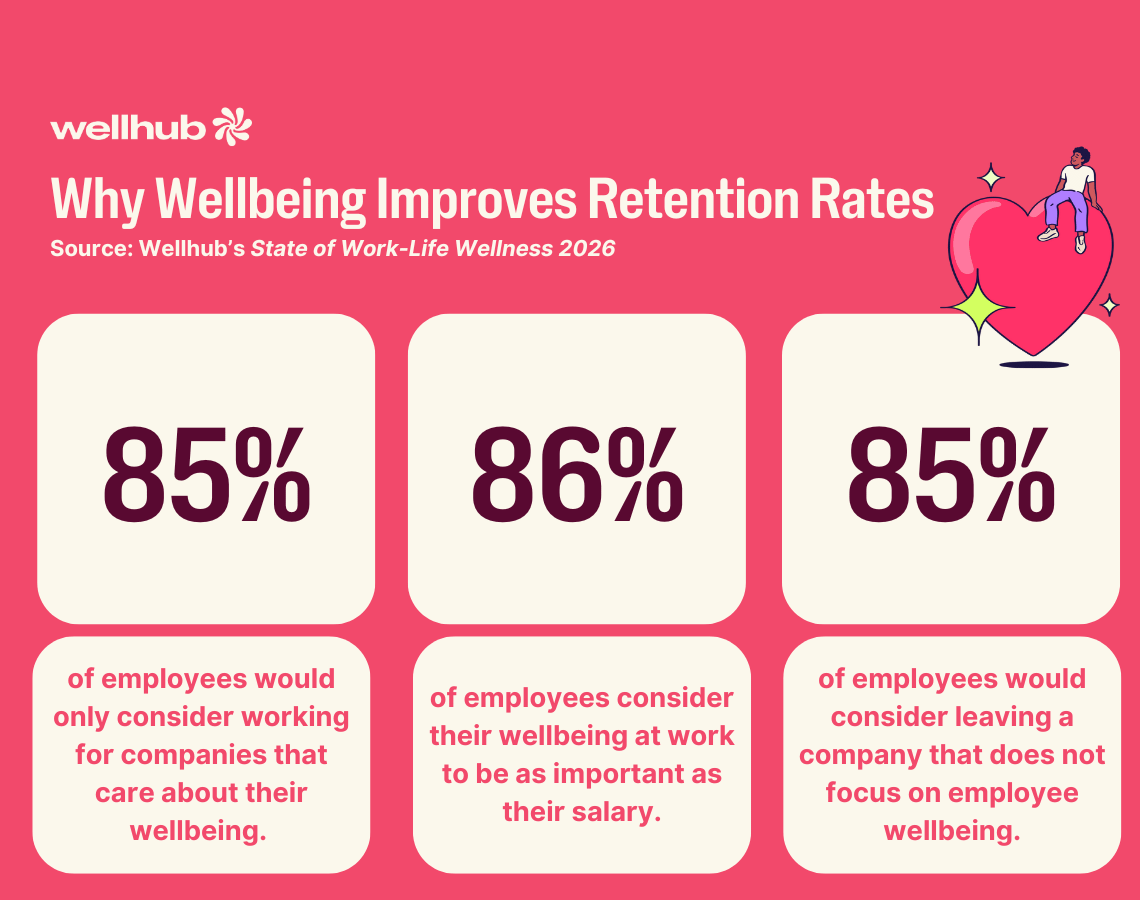
Best Practices That Drive Retention:
Research shows companies that provide holistic wellness benefits see significantly lower absenteeism and burnout. Support mental, physical, and emotional wellness through a well-rounded benefits package:
- Offer mental health support: virtual therapy, mental health days, or meditation app subscriptions.
- Provide access to fitness: subsidized gym memberships, virtual fitness platforms, or on-site classes.
- Build in preventative care: nutrition counseling, health screenings, and stress management workshops.
Flexible work isn’t just about remote options. It’s about autonomy and trust.
- Implement core hours + flexible scheduling, so employees can manage energy, not just time.
- Offer a results-first approach (not a seat-time model).
- Support caregivers with flexible leave and schedule accommodations.
Flexibility boosts trust and loyalty. When employees feel trusted to manage their own time, they’re more likely to stay and contribute fully.
Your best wellbeing program will fail if managers don't actively support it.
- Equip leaders to recognize burnout and stress.
- Set clear expectations that using wellbeing benefits is encouraged — not punished.
- Celebrate wellbeing wins just like performance wins.
Managers account for 70% of the variance in employee engagement, according to Gallup. They are your frontline defense against disengagement and quiet quitting.
Investing in wellbeing is a business imperative. When you create a culture where people feel cared for and in control of their work, they’re not just more likely to stay. They’re more likely to stay engaged. And in today’s retention economy, that’s everything.
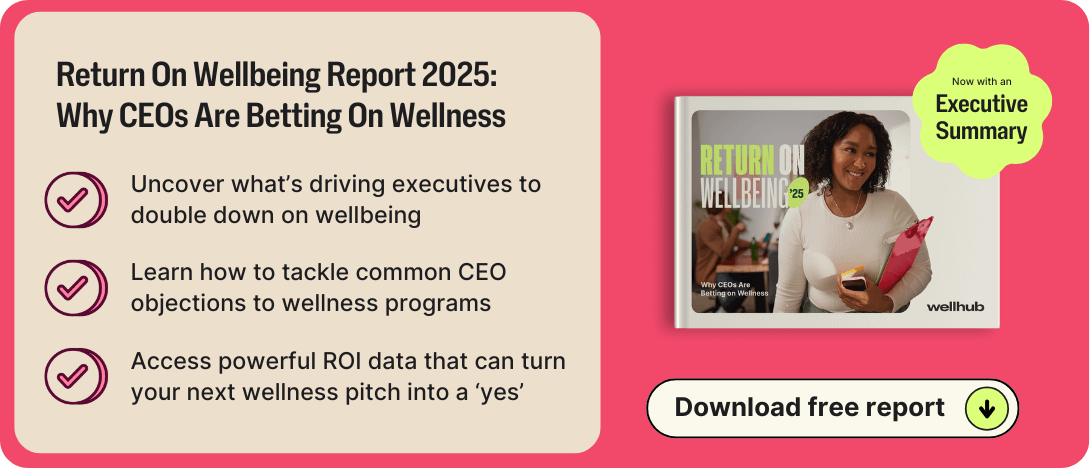
- Build a Culture People Want to Be Part Of
Retention isn’t only about paychecks and promotions — it’s about purpose, belonging, and values.
Best Practices:
- Celebrate wins and contributions. Public recognition (big or small) makes people feel seen.
- Foster psychological safety. Employees should feel safe to speak up, ask questions, and be themselves.
- Champion DEIB. Inclusive cultures retain more diverse talent, and drive innovation across the board.
Organizations with inclusive cultures have 22% less turnover than less-inclusive employers, according to Deloitte.
TL;DR — Retention Comes Down to Respect
Retention requires giving people a reason to stay. That means:
- Respecting their time and energy
- Listening and acting on feedback
- Supporting their growth and wellbeing
- Building a workplace that feels safe, fair, and inspiring
Improving Your Retention Rate Starts With Strong Wellbeing
Low retention rates often point to deeper issues like burnout, lack of career growth, and poor manager support. Even high retention can mask disengagement if employees feel stuck instead of supported.
A strategic wellbeing program helps resolve those challenges. It boosts engagement, supports mental and physical health, and gives employees the tools to thrive — not just survive. In fact, 73% of CEOs say their wellbeing programs directly improve employee retention. That’s not just good for people — it’s good for business.
Speak with a Wellhub Wellbeing Specialist to build a culture where people stay — because they want to.

Company healthcare costs drop by up to 35% with Wellhub*
See how we can help you reduce your healthcare spending.
[*] Based on proprietary research comparing healthcare costs of active Wellhub users to non-users.
Category
Share

The Wellhub Editorial Team empowers HR leaders to support worker wellbeing. Our original research, trend analyses, and helpful how-tos provide the tools they need to improve workforce wellness in today's fast-shifting professional landscape.
Subscribe
Our weekly newsletter is your source of education and inspiration to help you create a corporate wellness program that actually matters.
Subscribe
Our weekly newsletter is your source of education and inspiration to help you create a corporate wellness program that actually matters.
You May Also Like

Talent Management: Definition, Benefits, and Strategies | Wellhub
Discover talent management best practices to attract, retain, and develop top talent. Leverage these benefits and strategie to align with your business goals.

Employment At Will: What It Means for Employers | Wellhub
At-will employment offers termination flexibility for employers and employees. Explore strategies to mitigate risks and ensure fair practices in the workplace.

6 Essential Team Lead Responsibilities | Wellhub
Team leads take on many responsibilities to help their team be successful. Discover which responsibilities are the most critical for success.